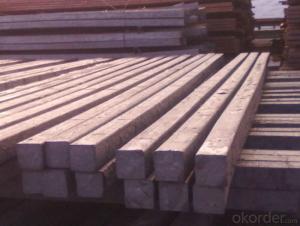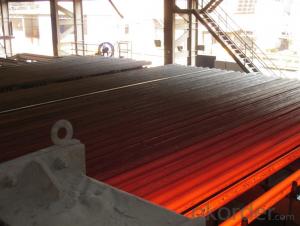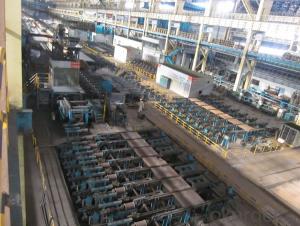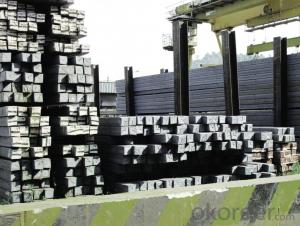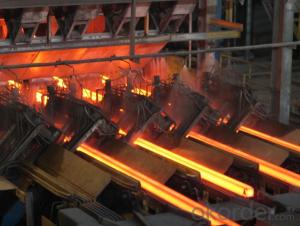Prime Q275 80mm Square Alloy Steel Billet
- Loading Port:
- Shanghai
- Payment Terms:
- TT OR LC
- Min Order Qty:
- 100 m.t.
- Supply Capability:
- 10000 m.t./month
OKorder Service Pledge
OKorder Financial Service
You Might Also Like
Structure of Prime Q275 80mm Square Alloy Steel Billet

Description of Prime Q275 80mm Square Alloy Steel Billet
1. Prepainted steel coil is coated with organic layer, which provides higher anti-corrosion property and a longer lifespan than that of galvanized or galvalume steel sheets.
2. The base metals for prepainted steel coil consist of cold rolled, HDGI Steel, electro-galvanized and hot-dip alu-zinc coated steel. The finish coats of prepainted steel coil can be classified into groups as follows: polyester, silicon modified polyesters, polyvinylidene fluoride, high-durability polyester, etc.
3. The production process has evolved from one-coating-and-one-baking to double-coating-and-double-baking, and even three-coating-and-three-baking.
4. The color of the prepainted steel coil has a very wide selection, like orange, cream-colored, dark sky blue, sea blue, bright red, brick red, ivory white, porcelain blue, etc.
5. The prepainted steel coils can also be classified into groups by their surface textures, namely regular prepainted sheets, embossed sheets and printed sheets.

Main Feature of Prime Q275 80mm Square Alloy Steel Billet
Uncoated CR steel sheet
With the features of in line with the international highest standards in demension and shape, excellent surface finish and properties, the products are mainly used in home appliance and automobile industries.
Galvanized steel sheet(include HDG and EG)
With the features of good corrosion resistance, the products are mainly used in automobile, home appliance, electronics, building and machinery manufacture industries, etc.
Precoated steel sheet
With the features of enviromental protection and good processablility, long lasting surface durability, rich in colors, the products are maily used in building, home appliance and furniture industries, etc.
Applications of Prime Q275 80mm Square Alloy Steel Billet
A. Corrugated design makes it excellent waterproof performance
B. Materials as prepainted steel sheets, galvanized steel sheets, galvalume (Al-Zn coated sheets) are available to make corrugated sheet.
C.Those material are durable, anti-corrosion in bad weather for 20-30 years based on it's Zinc(Galvanized) coating or AZ (Galvalume) coating.
D. Different shape of the sheet make it suitable for any style of buildings.
E.Easy to install, no need special tools to fix the sheet.
F.Light weight due to high strength to weight ratio of steel. Light weight means easier handling lower shipping costs, easier installation
G. Different color is availbe base on the RAL Standard make your building more beautiful.
H. We will provide the best solutions if you don't have a exact idea of the specification you want for the steel sheet based on your weather conditions, engineering structure, construction budget and so on.

Specifications of Prime Q275 80mm Square Alloy Steel Billet
Product | Billet |
Material Grade | SGCC / SGCH / DX51D+AZ, etc |
Thickness | 0.6-3.0mm |
Width | 500-1500mm |
Tolerance | Thickness: +/-0.02mm , Width:+/-2mm |
Zinc-coating | Z30-150g/m2 |
Technique | Raw material: Hot rolled steel coil --> Cold rolled_>hot dipped galvalume |
Surface | Dried, Chromated, Unoiled |
Spangle | Regular spangle , small spangle, zero spangle |
ID | 508MM 610MM |
Coil weight | 1-25MT |
Export package | Cardboard inner sleeves, Waterproof paper, galvanized steel covered and steel strip packed |
FAQ of Prime Q275 80mm Square Alloy Steel Billet
We have organized several common questions for our clients,may help you sincerely:
1. How Can I Visit There?
Our company is located in Tianjin City, China, near Beijing. You can fly to Tianjin Airport Directly. All our clients, from home or aboard, are warmly welcome to visit us!
2. How Can I Get Some Sample?
We are honored to offer you sample.
3. Why choose CNBM?
Our delivery time about 15-20days for standard sizes, if you have other requirements like hardness, quanity and width ,it is about 20-40days. But don't worry we also try our best for the delivery time ,because time longer and our cost is higher.
- Q:What is the role of steel billets in the production of valves and fittings?
- Steel billets play a crucial role in the production of valves and fittings. Valves and fittings are essential components in various industries, including oil and gas, petrochemical, water treatment, and many others. These components need to be strong, durable, and able to withstand high pressure and temperature conditions. Steel billets, which are semi-finished products made from molten steel, serve as the starting material for the production of valves and fittings. They are typically cast into specific shapes and sizes, such as round, square, or rectangular, to meet the requirements of the final product. The use of steel billets allows manufacturers to ensure consistent quality and performance of valves and fittings. The billets are carefully selected based on their chemical composition, mechanical properties, and microstructure, ensuring that they possess the necessary characteristics for the desired end product. Once the steel billets are obtained, they undergo various manufacturing processes, such as forging, machining, and heat treatment, to shape them into the final valve and fitting components. These processes help enhance the strength, integrity, and functionality of the products. Steel billets also offer versatility in terms of customization. They can be easily cut, shaped, and formed to create valves and fittings with different configurations, sizes, and designs, meeting the specific requirements of different applications and industries. Overall, steel billets are essential in the production of valves and fittings as they provide the raw material from which these components are made. Their strength, durability, and ability to be customized make them a critical element in ensuring the reliability and performance of valves and fittings in various industrial settings.
- Q:Are steel billets prone to corrosion?
- Corrosion is not an inherent issue for steel billets. However, the likelihood of corrosion occurring depends on the specific steel type used and the environmental conditions in which they are placed. For instance, stainless steel billets possess a considerable amount of chromium, resulting in the formation of a protective layer on the surface that greatly enhances their resistance to corrosion. Conversely, carbon steel billets lack this protective layer, leading to increased vulnerability to corrosion. The presence of moisture, oxygen, and particular chemicals can expedite the corrosion process. Therefore, it is essential to handle and store steel billets appropriately, while also applying suitable coatings or treatments to minimize the risk of corrosion.
- Q:How do steel billets contribute to the overall recyclability of a product?
- Steel billets contribute to the overall recyclability of a product by being a primary raw material in steel production. When a product made of steel reaches the end of its life cycle, it can be recycled and transformed into new steel products using steel billets. This reduces the need for extracting and refining new raw materials, conserves energy, and minimizes waste, making the overall recycling process more efficient and sustainable.
- Q:What are the different types of surface finishes available for steel billets?
- Steel billets have a range of surface finishes that cater to specific needs and offer distinct qualities. Some of the most commonly used surface finishes for steel billets include: 1. Hot Rolled: This is the most basic finish achieved by heating the steel billet above its recrystallization temperature and then rolling it to the desired shape and size. Hot rolled steel billets have a rough and scaled surface, suitable for applications where aesthetics are not a primary concern. 2. Cold Rolled: This finish is obtained by subjecting the hot rolled billets to a series of cold rolling processes. Cold rolled steel billets have a smoother and refined surface, with tighter tolerances and improved dimensional accuracy. 3. Pickled and Oiled: This finish involves removing rust, scale, or mill scale from the steel billets by immersing them in an acidic solution, known as pickling. After pickling, the steel billets are oiled for temporary corrosion protection. This finish is ideal for applications where cleanliness and corrosion resistance are crucial. 4. Galvanized: Galvanizing is a process that coats the steel billets with a layer of zinc for enhanced corrosion resistance. This finish is particularly suitable for outdoor applications or high humidity environments, offering protection against rust and corrosion. 5. Electroplated: Electroplating involves depositing a thin layer of metal, such as nickel or chromium, onto the steel billets through an electrochemical reaction. This finish enhances aesthetics, corrosion resistance, and can provide specific functional properties like hardness or wear resistance. 6. Powder Coated: Powder coating is a technique where dry powder is electrostatically applied to the steel billets and then cured under heat to form a durable and protective coating. This finish offers excellent corrosion resistance, impact resistance, and a wide range of color options, making it popular in architectural and decorative applications. 7. Anodized: Anodizing, commonly used for aluminum, can also be applied to steel billets. This process creates an oxide layer on the steel's surface through electrolysis. Anodized steel billets exhibit improved corrosion resistance, increased hardness, and can be dyed in various colors for aesthetic purposes. These examples illustrate the variety of surface finishes available for steel billets. The choice of finish depends on specific requirements such as aesthetics, corrosion resistance, durability, and functional properties.
- Q:What are the different types of machining processes used for shaping steel billets?
- There are several types of machining processes used for shaping steel billets, including turning, milling, drilling, and grinding. Turning involves rotating the billet against a cutting tool to remove excess material and create a desired shape. Milling uses rotary cutters to remove material from the billet, while drilling creates holes using a rotating cutting tool. Grinding involves using an abrasive wheel to remove material and achieve a smooth surface finish. These processes can be performed individually or in combination to achieve the desired shape and dimensions of the steel billet.
- Q:How do steel billets contribute to the manufacturing of textile machinery?
- Steel billets are a crucial component in the manufacturing of textile machinery due to their mechanical properties and versatility. Steel billets are essentially semi-finished steel products, typically in a rectangular or square shape, that are used as raw material in various industries, including textile machinery manufacturing. One of the primary ways steel billets contribute to the manufacturing of textile machinery is through the production of structural components. Textile machinery requires sturdy and durable frames, supports, and other structural elements to ensure stability and efficient functioning. Steel billets, with their high strength and rigidity, serve as an ideal material for these components. They can be easily shaped, machined, or welded to create intricate and complex structures that can withstand the heavy loads and vibrations associated with textile machinery. Additionally, steel billets are often used to produce shafts, gears, and other moving parts in textile machinery. These components need to have excellent wear resistance, high tensile strength, and good machinability to ensure smooth operation and a long service life. Steel billets, through various processes such as forging, rolling, or machining, can be transformed into these critical parts, providing the necessary mechanical properties and precision required for textile machinery. Moreover, steel billets are utilized in the manufacturing of tooling and molds used in textile machinery production. These tools and molds are essential for shaping and forming various components or parts of the machinery. Steel billets, when subjected to heat treatment and precise machining processes, can be transformed into high-quality tooling and molds that offer exceptional dimensional accuracy and durability. This contributes to the overall efficiency and quality of textile machinery production. In summary, steel billets play a pivotal role in the manufacturing of textile machinery by providing the raw material for structural components, moving parts, and tooling. Their mechanical properties, versatility, and ease of fabrication make them an indispensable material for the industry. Steel billets ensure the durability, precision, and functionality of textile machinery, ultimately contributing to the overall performance and reliability of the equipment.
- Q:How do steel billets contribute to the manufacturing of telecommunications equipment?
- Steel billets play a crucial role in the manufacturing of telecommunications equipment by providing the necessary raw material for various components and structures. These billets, typically made from carbon steel, are semi-finished products that are further processed to create specific shapes and sizes required for telecommunications equipment. One of the key ways steel billets contribute to the manufacturing of telecommunications equipment is by serving as the base material for the fabrication of towers and masts. These structures are vital for the installation of antennas and satellite dishes, enabling the transmission and reception of signals for telecommunications networks. Steel billets are shaped and welded to create sturdy and durable towers that can withstand various environmental conditions. Moreover, steel billets are also used in the production of enclosures and cabinets for housing telecommunication equipment. These enclosures provide protection from external factors such as dust, moisture, and vandalism, ensuring the proper functioning and longevity of the equipment. Steel billets are formed into panels, frames, and chassis that are then assembled to create robust enclosures that can withstand harsh environments. In addition, steel billets contribute to the manufacturing of telecommunications equipment by being used in the production of cable trays and supports. These components are essential for organizing and routing cables, providing a neat and efficient infrastructure for telecommunications systems. Steel billets are rolled and formed into various shapes, such as channels and angles, to create sturdy cable trays and supports that can handle the weight and stress of multiple cables. Furthermore, steel billets are also utilized in the fabrication of connectors and brackets for telecommunications equipment. These small yet crucial components provide the necessary connections and support for different devices and modules in telecommunications systems. Steel billets are machined, drilled, and shaped into specific designs to create reliable connectors and brackets that ensure proper functionality and stability. Overall, steel billets play a vital role in the manufacturing of telecommunications equipment by providing the necessary raw material for various components and structures. Their strength, durability, and versatility make them an ideal choice for creating robust and reliable equipment that can withstand the demands of modern communication networks.
- Q:What are the different surface treatments applied to alloy steel billets?
- Some of the different surface treatments applied to alloy steel billets include hot rolling, cold drawing, peeling, grinding, and polishing. These treatments are used to improve the surface finish, dimensional accuracy, and overall quality of the billets.
- Q:What is the role of steel billets in the manufacturing of conveyor systems?
- The manufacturing of conveyor systems heavily relies on steel billets, which serve as the primary material for producing various components and parts. To begin with, steel billets play a vital role in constructing the framework and structure of the conveyor system. They are shaped and cut to form the main frame, supports, and other structural elements that provide stability and strength to the entire system. The superior strength and durability of steel make it an ideal material for this purpose, ensuring that the conveyor system can withstand heavy loads and operate efficiently. Moreover, steel billets are crucial in the fabrication of rollers and pulleys, which are indispensable components of conveyor systems. These rollers and pulleys are responsible for guiding and moving the conveyor belt, facilitating the smooth and uninterrupted flow of materials. Steel billets are forged and machined to create these components, guaranteeing their reliability and long lifespan even in demanding working conditions. Additionally, steel billets are also utilized in the production of brackets, connectors, and fasteners that secure the different parts of the conveyor system together. These components provide the necessary connections and attachments, ensuring the proper assembly and functioning of the conveyor system. Furthermore, steel billets offer the advantage of being moldable and shapeable into customized parts according to the specific requirements of the conveyor system. This flexibility allows conveyor manufacturers to design and manufacture conveyor systems that are tailored to the unique needs of various industries and applications. In conclusion, steel billets are essential in the manufacturing of conveyor systems as they provide the raw material for constructing the system's framework, rollers, pulleys, brackets, connectors, and other components. The high strength, durability, and flexibility of steel billets make them a vital ingredient in creating reliable and efficient conveyor systems.
- Q:How are steel billets cleaned before further processing?
- Steel billets are typically cleaned before further processing through a process known as descaling. This involves removing any mill scale or oxides on the surface of the billets using techniques such as shot blasting, pickling, or high-pressure water jetting. The cleaned billets are then ready for subsequent processing steps such as hot rolling or forging.
1. Manufacturer Overview |
|
|---|---|
| Location | |
| Year Established | |
| Annual Output Value | |
| Main Markets | |
| Company Certifications | |
2. Manufacturer Certificates |
|
|---|---|
| a) Certification Name | |
| Range | |
| Reference | |
| Validity Period | |
3. Manufacturer Capability |
|
|---|---|
| a)Trade Capacity | |
| Nearest Port | |
| Export Percentage | |
| No.of Employees in Trade Department | |
| Language Spoken: | |
| b)Factory Information | |
| Factory Size: | |
| No. of Production Lines | |
| Contract Manufacturing | |
| Product Price Range | |
Send your message to us
Prime Q275 80mm Square Alloy Steel Billet
- Loading Port:
- Shanghai
- Payment Terms:
- TT OR LC
- Min Order Qty:
- 100 m.t.
- Supply Capability:
- 10000 m.t./month
OKorder Service Pledge
OKorder Financial Service
Similar products
New products
Hot products
Related keywords
